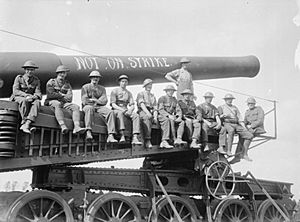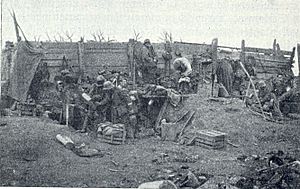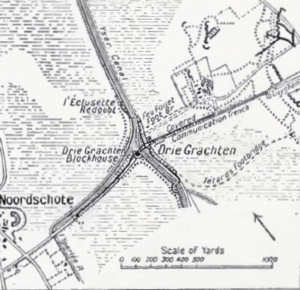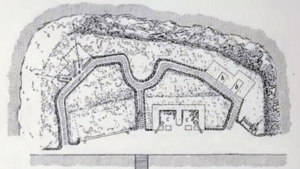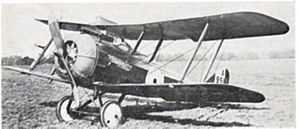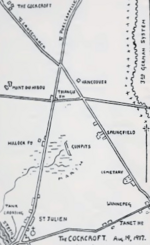Battle of Langemarck (1917) facts for kids
Quick facts for kids Battle of Langemarck |
|||||||
|---|---|---|---|---|---|---|---|
| Part of the Third Battle of Ypres in the First World War | |||||||
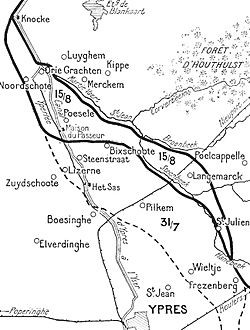 Front line after Battle of Langemarck, 16–18 August 1917 |
|||||||
|
|||||||
| Belligerents | |||||||
| Commanders and leaders | |||||||
| Strength | |||||||
| 10 divisions 8 British, 2 French |
6 Stellungsdivisionen 5 Eingreifdivisionen |
||||||
| Casualties and losses | |||||||
| 16–28 August: 36,190 | 11–21 August: 24,000 16–18 August: 2,087 POW |
||||||
The Battle of Langemarck took place from August 16 to 18, 1917. It was a major attack by British and French forces during the Third Battle of Ypres in World War I. The battle happened near Ypres in Belgium, on the Western Front. The goal was to push back the German 4th Army.
The French army had a big success on the northern side. They gained a lot of ground. The British also moved forward north of Langemark. However, on the southern side, the British faced strong German resistance. They captured some land but couldn't reach all their targets. German forces quickly counter-attacked and took back much of the lost area.
Heavy rain in August made the battlefield a muddy mess. This made it very hard for soldiers to move. It also made it difficult for planes to help guide artillery fire. The bad weather and tough German defense caused the British to pause their attack for three weeks. Later, in September, the weather improved. The ground dried, and the British continued their offensive. They had more success in other areas before the rains returned.
Contents
Background to the Battle
Why the Battle Happened
The First World War was a global conflict. In 1917, the Allies (like Britain and France) wanted to break through German lines. They hoped to capture the Belgian coast. This would stop German submarines that were a threat in the North Sea. The Third Battle of Ypres began on July 31, 1917. The first attacks, like the Battle of Pilckem Ridge, had some success.
However, the battlefield quickly turned into a muddy swamp. Heavy shelling had destroyed drainage systems. Unusually heavy rain made the ground like thick porridge. Soldiers struggled to move, and supplies were hard to bring to the front. This made fighting very difficult for everyone.
Weather Conditions
The weather played a huge role in the battle. August 1917 was unusually wet. Over 127 millimeters (about 5 inches) of rain fell that month. This was much more than usual. The constant rain and cloudy skies meant the ground didn't dry out. This created deep mud and water-filled shell craters. Soldiers could even drown if they fell into these craters. This made the battlefield a nightmare.
Preparing for the Attack
British Plans
The British planned their attack carefully. They wanted to advance step by step. This would keep their soldiers safe under the cover of artillery fire. They aimed to capture specific lines of German defenses. Tanks were supposed to help, but the muddy conditions made them almost useless.
Soldiers practiced how to "hug" (stay close to) their own artillery fire. This was a moving wall of shells that protected them. They also learned to deal with German strongpoints, which were small, fortified positions called pillboxes. These were hard to destroy. The attack was delayed several times due to the rain.
German Defenses
The German army had strong defenses. They had several lines of trenches and fortifications. These included the Albrechtstellung (second position) and the Wilhelmstellung (third position). These lines were filled with concrete bunkers, or pillboxes, and machine-gun nests.
The Germans also used a strategy called defense in depth. This meant they had soldiers spread out in different layers. If the first line was broken, reserve troops called Eingreif divisions would quickly counter-attack. They wanted to wear down the attackers and take back any lost ground. The area was also flooded in some parts, making it even harder for attackers.
The Battle Begins
British Attacks
The attack started at 4:45 a.m. on August 16. British artillery fired a "creeping barrage" that moved forward. The infantry followed closely behind it.
II Corps Attacks
On the southern flank, the 18th (Eastern) Division faced heavy machine-gun fire. They struggled to advance. The 56th (1/1st London) Division also had a tough time. They got stuck in deep mud and faced hidden German snipers. Tanks could not help them.
The 8th Division advanced well at first. They crossed a stream called the Hanebeek. But their left side was exposed because another division couldn't keep up. This allowed German machine-gunners to fire at them from the side. Despite this, they captured several strongpoints.
XIX Corps Attacks
The 16th (Irish) Division and 36th (Ulster) Division attacked further north. They had already suffered many losses before the battle. They faced strong German positions that had not been destroyed by artillery. Many soldiers were lost. Some German pillboxes were not fully cleared. This allowed German soldiers to fire at the British from behind.
XVIII and XIV Corps Attacks
The 48th (South Midland) Division captured some key positions. They faced counter-attacks but held their ground. The 11th (Northern) Division also advanced. They pushed beyond Langemarck village.
The 20th (Light) Division and 29th Division (XIV Corps) had more success. They reached their targets quickly. They captured Langemarck and the German Wilhelmstellung (third position) north of the railway. They faced some counter-attacks later in the day, but held most of their gains.
French Attacks
The French First Army attacked on the northern side. Their targets included the Drie Grachten bridgehead. The German defenses here were easier to see and destroy. The flooded areas made it hard for Germans to move reserves.
The French crossed the Yperlee Canal and pushed back the Germans. They captured many strongpoints. They also helped the British by securing their northern flank. By August 17, the French had moved their line forward significantly. They captured over 400 prisoners and many guns.
Air Operations
Mist and clouds made it hard for planes to see on August 16. This meant they couldn't help guide artillery fire as much as planned. However, they were better at spotting German artillery positions. British and French planes also attacked German airfields and troop movements. They tried to break up German counter-attacks.
German Counter-attacks
The Germans launched strong counter-attacks. They used fresh divisions and heavy artillery. On the southern flank, the 34th Division pushed back the British 56th Division. The 8th Division, which had advanced far, found itself surrounded by German fire. They were forced to retreat to their starting positions.
The 16th (Irish) and 36th (Ulster) Divisions also faced powerful German counter-attacks. German smoke shells hid their movements from British observers. Many British soldiers were killed or captured. The Germans managed to push back the British in these areas. However, further north, where the British and French had advanced more easily, German counter-attacks were less successful.
Aftermath of the Battle
Losses
The Battle of Langemarck was very costly for both sides. The British suffered over 36,000 casualties (killed, wounded, or missing) between August 16 and 28. The Germans had about 24,000 casualties from August 11 to 21. This included over 2,000 prisoners. The constant rain and heavy fighting exhausted the soldiers.
Later Actions
After the battle, the British paused their main offensive. The ground was too muddy, and their troops were tired. They used this time to improve roads and bring in more artillery. They also changed their tactics. The main focus of the attack shifted south. This led to more successful battles later in September.
Action of the Cockcroft
On August 19, British troops attacked German strongpoints near St Julien. These included fortified farms and pillboxes. Tanks helped by driving the German defenders into cover. This allowed the infantry to capture the positions with fewer losses. This small action showed how new tactics could help overcome strong defenses.
Images for kids


